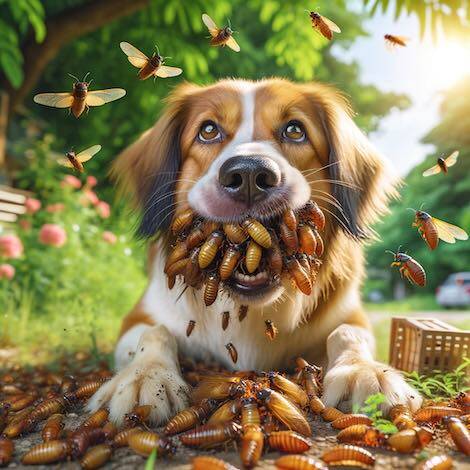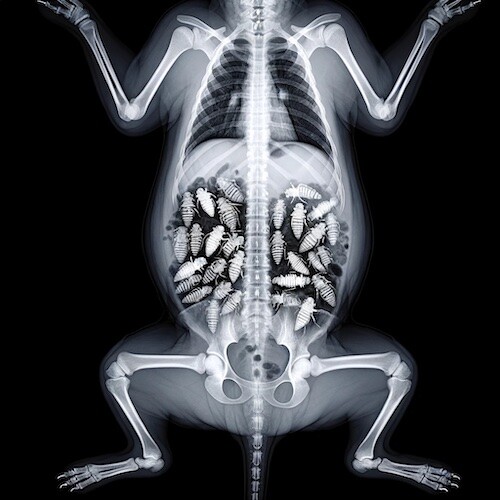
The Hidden Threat: How Cicadas Can Be Deadly to Dogs
As the summer months approach, the familiar hum of cicadas fills the air, signaling their emergence from underground. These insects, which spend most of their lives as nymphs beneath the soil, come above ground in massive numbers to mate and lay eggs. While their presence can be an annoyance to humans, they pose a potentially deadly threat to our canine companions. This article explores the ways cicadas can be dangerous to dogs, shedding light on an issue that pet owners must be aware of during cicada season.
Understanding Cicadas
Cicadas are large, winged insects known for their loud mating calls, produced by the rapid vibration of membranes called tymbals. They have a life cycle that includes long periods spent underground as nymphs, where they feed on the sap of tree roots. Depending on the species, cicadas can emerge in cycles of 1, 13, or 17 years. When they do surface, their sheer numbers can be overwhelming.
The periodic emergence of cicadas is a fascinating natural phenomenon. These insects are divided into two main groups: annual cicadas, which appear every year, and periodical cicadas, which emerge in synchronized broods after spending 13 or 17 years underground. The latter group is particularly notorious for their large-scale emergences, with billions of cicadas emerging simultaneously, covering trees, lawns, and even buildings.
The Attraction for Dogs
Dogs are naturally curious creatures, and the sudden appearance of thousands of cicadas can be irresistible. The movement and sound of these insects can trigger a dog’s hunting instincts, leading them to chase, catch, and eat the cicadas. While this behavior might seem harmless, it can have serious consequences.
Gastrointestinal Blockages
One of the most immediate dangers of dogs consuming cicadas is the risk of gastrointestinal blockages. Cicadas have hard exoskeletons made of chitin, which are difficult for dogs to digest. When ingested in large quantities, these exoskeletons can accumulate in the stomach or intestines, leading to blockages. Symptoms of a gastrointestinal blockage include vomiting, lethargy, loss of appetite, and abdominal pain. If left untreated, this condition can be life-threatening and may require surgical intervention.

Symptoms and Diagnosis of Blockages
The signs of a gastrointestinal blockage can vary depending on the location and severity of the obstruction. Dogs with a blockage in the stomach might vomit frequently and show signs of discomfort, while those with an intestinal blockage may experience more severe symptoms such as abdominal swelling and persistent pain. In some cases, the blockage can cause a complete stop in the passage of food and fluids, leading to rapid deterioration of the dog’s condition.
Diagnosis of gastrointestinal blockages typically involves a combination of physical examination, imaging studies such as X-rays or ultrasound, and sometimes endoscopy. These tools help veterinarians identify the location and extent of the blockage and determine the best course of treatment.
Treatment and Recovery
Treatment for gastrointestinal blockages often requires surgical intervention, especially if the blockage is severe or if the dog’s condition is deteriorating rapidly. The surgery involves removing the obstructing material, which in this case would be the cicada exoskeletons. Post-surgery, dogs need careful monitoring and supportive care to ensure a smooth recovery. This includes fluid therapy, pain management, and a gradual reintroduction to food.
Toxicity and Allergic Reactions
Although cicadas are not inherently toxic, some dogs may experience adverse reactions after consuming them. The bodies of cicadas can contain substances that irritate a dog’s digestive system, leading to vomiting and diarrhea. In rare cases, dogs might have allergic reactions to cicada proteins, which can cause symptoms ranging from mild discomfort to severe anaphylactic reactions. Signs of an allergic reaction include swelling, hives, difficulty breathing, and collapse. Immediate veterinary care is crucial if any of these symptoms occur.
Pesticide Exposure
During cicada emergences, it is common for people to use pesticides to control the population of these insects. Unfortunately, dogs that consume cicadas treated with these chemicals can be at risk of poisoning. Pesticides can cause a range of symptoms, including drooling, vomiting, diarrhea, muscle tremors, seizures, and even death. It is essential for pet owners to be aware of pesticide use in their surroundings and to prevent their dogs from ingesting cicadas in treated areas.
Behavioral and Environmental Risks
Beyond the direct physical dangers, the presence of cicadas can also lead to behavioral and environmental risks for dogs. The noise generated by cicadas can be distressing to some dogs, causing anxiety and stress. Dogs might exhibit signs of agitation, such as barking, whining, or attempting to escape from the noise. In their attempts to catch cicadas, dogs may run into hazardous areas, such as busy roads or dense underbrush, increasing the risk of injury or getting lost.
Behavioral Signs of Cicada Anxiety
Some dogs are more sensitive to noise than others, and the constant buzzing of cicadas can be particularly unsettling. Dogs experiencing anxiety due to cicada noise may show signs such as panting, pacing, excessive barking, and attempts to hide or escape. In severe cases, noise anxiety can lead to destructive behaviors, as dogs may chew on furniture, dig at doors, or try to break through barriers to escape the sound.
Managing Noise Anxiety
Managing noise anxiety in dogs requires a multifaceted approach. Creating a calm and safe environment is crucial. This can involve setting up a quiet space in the home where the dog feels secure, using white noise machines to mask the cicada sounds, and providing comfort through physical touch and reassurance. In some cases, veterinarians may recommend anxiety-reducing medications or supplements to help dogs cope with the stress.

Prevention and Safety Tips
To protect dogs from the dangers associated with cicadas, pet owners should take several preventive measures:
Supervision: Monitor dogs closely when they are outside during cicada season. Keeping a watchful eye can help prevent them from eating cicadas or running into dangerous areas.
Environmental Control: Limit a dog’s access to areas with high cicada populations. This might involve keeping dogs indoors during peak cicada activity times or creating a secure outdoor space.
Training: Teach dogs commands such as “leave it” or “drop it” to discourage them from picking up cicadas. Positive reinforcement techniques can be effective in training dogs to avoid these insects.
Pesticide Awareness: Be mindful of pesticide use in the area and ensure that dogs do not have access to treated cicadas or contaminated areas.
Veterinary Consultation: If a dog exhibits any signs of gastrointestinal distress, allergic reactions, or other unusual symptoms after ingesting cicadas, seek veterinary attention immediately. Early intervention can prevent serious health complications.
Cicada Seasons Around the World
Cicadas are found in many parts of the world, and their emergence seasons vary depending on the region and species. In North America, periodical cicadas are most famous for their synchronized emergences. In contrast, annual cicadas appear every year, usually from late spring to early summer. Understanding the local cicada patterns can help pet owners prepare and take preventive measures.
Case Studies: Real-Life Incidents
Examining real-life incidents can provide valuable insights into the risks posed by cicadas to dogs. One notable case involved a Labrador Retriever named Max, who was found to have consumed a large number of cicadas during a periodical emergence. Max began exhibiting signs of distress, including vomiting and lethargy. A veterinary examination revealed a gastrointestinal blockage caused by the accumulation of cicada exoskeletons. Max required emergency surgery to remove the blockage and eventually made a full recovery.
Another case involved a smaller dog, a Dachshund named Bella, who experienced an allergic reaction after ingesting cicadas. Bella’s face began to swell, and she had difficulty breathing. Her owner rushed her to the veterinarian, where she received immediate treatment, including antihistamines and corticosteroids. Bella’s quick recovery underscored the importance of rapid intervention in cases of allergic reactions.
The Role of Veterinarians
Veterinarians play a crucial role in managing and treating the health issues caused by cicada consumption in dogs. They provide essential services, including diagnosing gastrointestinal blockages, treating allergic reactions, and managing pesticide poisoning. Educating pet owners about the risks and preventive measures is also a key aspect of their role.
Veterinary clinics can prepare for cicada season by having protocols in place for treating related health issues. This includes stocking necessary medications, having surgical teams ready for emergency procedures, and offering educational materials to pet owners. By being proactive, veterinarians can help reduce the incidence of severe health problems related to cicada consumption.
Community Awareness and Education
Raising community awareness about the potential dangers of cicadas to dogs is essential. Pet owners, local governments, and community organizations can work together to disseminate information and promote safe practices. This can involve creating informational brochures, hosting community workshops, and using social media to reach a broader audience.
Public awareness campaigns can emphasize the importance of supervision, environmental control, and prompt veterinary care. Highlighting real-life case studies and expert advice can make the information more relatable and impactful. By fostering a community-wide understanding of the risks, we can better protect our canine companions during cicada season.
Conclusion
While cicadas are a fascinating part of the natural world, their presence can pose significant risks to dogs. By understanding these dangers and taking proactive steps to protect their pets, owners can ensure a safe and enjoyable summer for their canine companions. Awareness and vigilance are key in preventing the potentially deadly consequences of cicada interactions with dogs.
The emergence of cicadas, though a natural and periodic event, requires pet owners to be especially attentive to their dogs’ behaviors and health. Through education, preventive measures, and community involvement, we can mitigate the risks and ensure that our pets stay safe and healthy during cicada season.
